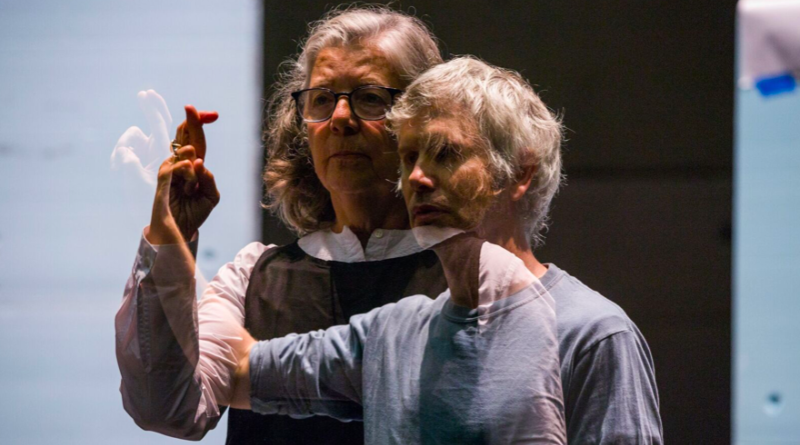INTERVIEW: John Heginbotham’s new dance finds inspiration from Swiss author
Photo: HERZ SCHMERZ is based on the writings of Robert Walser and features choreography by John Heginbotham. Photo courtesy of Whitney Browne / Provided by press rep with permission.
Choreographer John Heginbotham has made New York City’s Baryshnikov Arts Center something of a home these past few years. He has premiered works in 2012, 2014 and now 2019 at the off-Broadway, multidisciplinary venue.
His latest is a project with his frequent collaborator — author, painter, illustrator Maira Kalman. This time around they are exploring the words of early 20th century Swiss writer Robert Walser, in particular his novella The Walk.
The new piece is called HERZ SCHMERZ, and it involves melodic chamber music, movement and text. The resulting performance, which plays Oct. 10-12, is one centered on “a hyper-detailed, eccentric human landscape of peculiar encounters and gossamer vulnerability.”
Heginbotham is a former member of the Mark Morris Dance Group, and in 2011, he founded Dance Heginbotham, which has presented dances around the world. He is the recipient of a Guggenheim Fellowship and the Jacob’s Pillow Dance Award. He is currently represented on Broadway with Daniel Fish’s unique take on Oklahoma!
Recently Hollywood Soapbox exchanged emails with the choreographer about the new work. Questions and answers have been slightly edited for style.
How did you find the work of Robert Walser, and what is it about his work that inspired you to create a dance piece?
My longtime friend and collaborator, the artist/author Maira Kalman, made me aware of Robert Walser. We had even tried a few experiments using his text for a piece from a couple of years ago called The Principles of Uncertainty, but ended up not incorporating it there. With HERZ SCHMERZ, we went full force back to his writing. In particular, we drew inspiration from his short novella, The Walk, and a very short story called Nervous.
Do you believe Walser’s writings speak to society in 2019?
Absolutely. The themes in many of his stories are centered on isolation, romance, heartbreak — certainly familiar themes to many of us. Frequently, an extremely dry humor lives within the isolation and flirtation. The humor sometimes strikes me as feeling contemporary when I read it.
What’s it like to collaborate with Maira Kalman?
I love collaborating with Maira. We’ve known each other since the late 1990s and have worked together in a bunch of different contexts. She has a huge, wonderful imagination, and she’s interested in poetic ways of telling a story — as in her books, in which she sometimes plays with the conventions of how one experiences a book (in her book The Principles of Uncertainty, the reader has [to] turn the book on its side for a chapter in order to continue, and she often uses her own handwriting to convey the story).
There are many great things about knowing and collaborating with Maira, but maybe the top two are that she comes up with magical, elegant, fantastic ideas which would never have occurred to me (we’re not always thinking exactly the same thing, which is wonderful), and she is extremely kind.
How challenging is this piece from the performers’ perspective?
I think pretty challenging at least for some of the show. All of the performers are being asked to do something beyond their areas of expertise. People who don’t ordinarily dance (at least in the way we’re dancing in this production) are performing quite complicated sequences of movement, and everyone is speaking (even the people who have rarely ever spoken on stage) — delivering ornate and non-intuitive, but beautiful text. Sometimes the performers are doing the talking and the dancing simultaneously. Because they are all doing something apart from their professions, it gives them a vulnerability which is captivating to me, but I’m sure it’s also very challenging for them.
Did the music by composer Hans Huber help you with the choreography?
Totally. I found the music while researching Swiss composers who were contemporaries of Walser, and Huber’s music really feels like some of Walser’s writing — sometimes tender and melancholy, sometimes energized and hopeful. The music inspired specific movement sequences, but also specific scene ideas — when to make something expansive and very active, and when to iris in on an intimate setting.
What’s the dance scene like right now in New York City?
Eclectic, which is great — a lot of strong individual choreographic voices. In concert dance anyway, there is a trend toward highly structured and technical dancing (which was not embraced as much a few years ago). Also, the prominence of choreographers who are women is finally starting to grow. The field has been dominated by men, and that is gradually starting to change.
By John Soltes / Publisher / John@HollywoodSoapbox.com
HERZ SCHMERZ, featuring choreography by John Heginbotham, will play Oct. 10-12 at the Baryshnikov Arts Center in New York City. Click here for more information and tickets.

